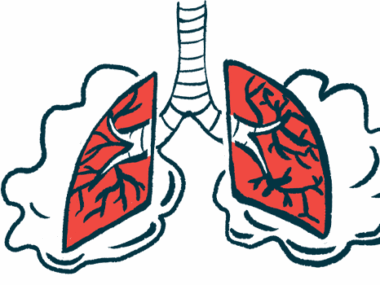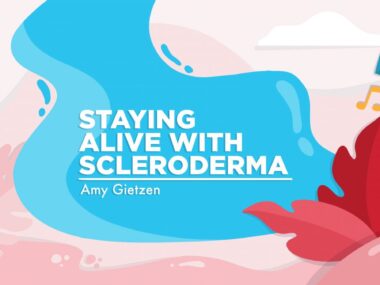My scleroderma diagnosis journey: What a long, strange trip it’s been
A columnist finds out about scleroderma from the 'National Enquirer'
Written by |

I’m 61 years old and live in a city over 100 miles away from a scleroderma care center. I’ve been diagnosed with the disease several times over the past 30 years, and it took me an equal amount of time to get referred to the Stanford University Scleroderma Center in California. I’m hoping to start going there for care next month.
My scleroderma symptoms began in childhood when I was about 8 years old. I had shortness of breath and lightheadedness, and I couldn’t keep up with the other kids running around on the playground. These problems might’ve gone unnoticed, but thankfully, a teacher told my mother I looked like I was going to pass out on the playground.
My pediatrician diagnosed me with a mild case of rheumatic fever, and I had to get blood tests a couple times a month for about two years. No one I knew had ever heard of scleroderma, not even my pediatrician.
I was 11 when I heard of scleroderma after reading about it in the “National Enquirer.” “Scleroderma — The Disease that Turns People to Stone!” the headline shouted. “Thank God I don’t have that,” I thought.
But I did, although I wouldn’t know it until decades later.
After a high school physical revealed no trace of rheumatic fever, my life was relatively uneventful. In my 20s, I fell in love, got married, and had a child. Then, I began to feel very ill. I felt so bad and exhausted that I had trouble taking care of my infant daughter. Several doctors dismissed my concerns. “All new mothers are tired,” one said.
When my daughter was 2, a dermatologist finally put it all together after ordering tests. “You have scleroderma,” she said.
Other tests showed heart, gastrointestinal, and lung involvement. I could feel my skin tightening and my tendons shortening. I was given penicillamine, apparently to prevent the disease’s progression in my internal organs. It didn’t do much, if anything, except improve my skin a little.
Over the years, my symptoms got worse and my scleroderma diagnosis went back and forth between the limited and diffuse types. (Limited scleroderma is milder and more common than diffuse scleroderma.)
My community doctors, who didn’t know about the disease that turns people to stone, attributed my worsening symptoms to other causes, such as my lifestyle. Because I was unable to access care at a scleroderma center, I couldn’t access clinical trials for other potential treatments. My care has been stuck in the previous century.
I’d like for you to get to know me through this column, which will describe my scleroderma journey so far. It’ll be like a journal of my care at an accredited scleroderma center, with the goal of bringing my scleroderma trip out of the darkness and into the light.
And what a long, strange trip it’s been!
Note: Scleroderma News is strictly a news and information website about the disease. It does not provide medical advice, diagnosis, or treatment. This content is not intended to be a substitute for professional medical advice, diagnosis, or treatment. Always seek the advice of your physician or other qualified health provider with any questions you may have regarding a medical condition. Never disregard professional medical advice or delay in seeking it because of something you have read on this website. The opinions expressed in this column are not those of Scleroderma News or its parent company, Bionews, and are intended to spark discussion about issues pertaining to scleroderma.







Ellen Galione
So sorry youre going thru this. Wow! so true a long journey for you
I also have scleroderma, diffuse. I was dx 7 years ago, , unfortunately there are not many doctors that have knowledge of this disease. I was lucky to find a doctor who specializes in scleroderma. I live in NJands am 74 yrs young!
I try to keep positive and hope it doesn't progress. Right now not too many symptoms. Affecting my hands mostly.
I know it's hard but try to keep as positive as you can. I am sending positive vibes to you, hoping you have some peace and free of pain. Thank you for sharing your story. Ellen
AnaMarie Medina
Hi Ellen!
I'm so happy to know that you are in your 70's!! I was diagnosed at 36 and I am now 56. I was hoping to learn of someone who is hopeful and inspiring on this journey. You give me hope! My worst-case scenario has been Raynaud's in my hands and feet, and some aches and pains from rheumatoid arthritis. My face and some parts of my body have changed due to the excessive collagen production in some areas of my face and limbs. But on the positive side i don't look my age and I am often mistaken for about ten years younger! Many blessings of health and healing to you and everyone on this journey!
Janice
First signs in 2007, 2009 high ANA of 1280, knew something was wrong, red dots on lips and gums letting go of teeth. I found out in 2021 that I have Scleroderma/Crest. I have hard white calcium type things that come out of a scar, skin is thickening. It’s the worst, I believe my Paternal Grandmother had it too .
Lisa
I was also diagnosed in 2007 with “crest” syndrome / limited scleroderma. I first saw changes to my hands- Raynauds and thickening of fingers. I’m thankful that Scleroderma has been in the background of my life but post menopause has been rough. The last 3-5 years my gums are receding and I’m losing teeth. I didn’t expect this! I’m thankful though to have good care.
Jay Pennock
I have been diagnosed with Scleroderma for the past 2 1/2 years after contracting COVID-19. I have tried multiple lifestyle interventions and some esoteric therapy but nothing really seems to be helping except maybe the hyperbaric oxygen chamber. Was wondering if you had any experience with non-Western medical providers that offered you solid advice. I do not think that Western medicine has any options until you are quite ill. Jay
Tomisa Starr
Dear Jay,
I am sorry to hear about your recent scleroderma diagnosis. Although I have not had experience with using non-Western medicine to manage the condition, taking Tai Chi classes has been suggested to me to help improve range of motion. For years, I have employed gentle walking as a way to maintain lung function.
Thank you for reading my column,
Tomisa
Mike
Thank you for sharing. Sometimes I just feel like nobody really knows or understands what SSc actually is. So seeing you write about some of the same things I'm feeling and going through........it really helps.
Keep fighting
Tomisa Starr
Mike,
Yes, most people don’t know about scleroderma, and many physicians don’t seem to understand it. I’m glad you found my story helpful.
Thanks, for reading,
Tomisa
Dawn mottola
Hi been fighting this battle for 17 years it only gets harder.the pain in my fingers is unbearable and nothing can be done.i suffer from diffused and finally moving to warmer climate.i hope everyone has a nice day. Xo Dawn
Jane Phillips
my mother has been diagnosed with limited scleraderma just would like to know how i can be of help to her and what to expect.
Tomisa Starr
Jane,
I am very sorry to hear that your mother has scleroderma! In my column there are links to websites with information about limited and diffuse types of scleroderma. Limited scleroderma is milder and more common than diffuse.
Thank you, for reading my column,
Tomisa
Gaynell Harding
Hello, I was diagnosed December 2020 by a rheumatologist in Berlin MD with limited scleroderma, I knew nothing about the disease except what I had read. He said it was the better of the 2 to have. Mine started out with very cold swollen hands, Raynauds I was told and was prescribed methotrexate as well as a hand prescription for pain. Neither of the medications really did nothing, I followed up with the rheumatologist and after a few visits he suggested that I get a second opinion. Was suggested a new rheumatologist in Baltimore MD, he was very nice but did nothing any different with medications, but he did send me to a vascular Dr, to check the capillaries in my fingers which were very restricted. I finally was able to get an appointment at Johns Hopkins Scleroderma center. I met with an M.D. who didn't have much else to offer, except for Botox injections which was not covered by insurance, had this done to different times and I had no change in my fingers. I am now having gastrointestinal problems and am on Nexium 40mg twice a day as well as Propulsid once a day, I have to be careful what I eat, otherwise I have terrible reflux. I was told that my scleroderma is caused by a gene, my Dads moms sister had terrible rheumatoid arthritis which is also an autoimmune disease so maybe this could be where I got the gene? It is a real struggle dealing with this condition, I did find another rheumatologist to go to, maybe has something new in his hat that might help me, Gaynell
Amy
Tomisa, thank you so much for sharing your scleroderma story. My story is similar and it's nice to know I'm/ we're not alone. There are many of us out there, tired and tight and brain fogged and confused, puffy fingers, fingers and toes blue and cramping, burping burning reflux, feeling itchy. Next time I feel alone I'll think of you :)
Maggie Diaz
I pray for ALL of us who have scleroderma and for years struggled with finally getting diagnosed but really few answers or relief for our symptoms. It is very difficult to accept when doctors finally diagnose it and then say we really do not know what causes scleroderma and there is no cure for it.
Deborah
Thank you for sharing! There are a few SSc specialists in southern CA, and thankfully I was diagnosed early.
I can't imagine how difficult it would be otherwise.
I had rare side effects from CellCept so cannot take it.
That seems to be the main treatment, other than am and pm GERD treatment, which helps with lung disease progression.
God bless
Sandra Korzer
I also have Scleraderma .
When I was in my 30’s I went to the doctors for something I can’t remember now .i walked out and he called me back , he asked how long had I have a mole on the back of my leg , he took a biobsy and and sent it of .it came back as a melanoma I had it cut out .
After a while when I had a check up with the dr , he told me I have a malignant melanoma.
I went to London to have it cut out , I was in there for 11 days.
They had cut a big hole in the left back lower leg and it was stapled .
I had to go back and have the staples removed then it was tightly bandaged.
Years later I now have lung fibrosis .
I also had all my fingers have been removed over time and now left with two thumbs .they also are not happy I have ulcers on the side of both thumbs .
I am waiting today to hear when I am going to hospital to have tests on my lungs and heart.
We all have to deal with it without getting depressed as there is nothing we can do to stop it .
I have never smoked so I guess I was one of the unlucky ones that have this .
SHERI R ROSE
you give so much hope and your story is so much like mine. I was diagnosed Crest 22 years ago and now it's SSC. I live with SSC, PAH and Gastro issues. My drs. really dont know what to do and back then 22 yrs ago they never heard of it. I just found a support group thru the National website and we have zoom calls every month which helps me and more importantly not to feel alone. I also found a clinic, only one in my State (NJ) and have appts in May with the Founder and also GI dr. who specialize in this condition. I look forward to more from you. You've helped me already. PS, Im having trouble right now typing this as my Raynauds is kicking in and I have no fingers!! I will stay tuned. thanks and b well
SHERI R ROSE
I have had it 22 years. Now that Im older it's getting worse. You have helped me in just reading what you shared. We are not alone anymore. I found a support group off the national website for my area and we have monthly zoom calls to support each other. I also have PAH and the Gastro issues that I manage daily. I look forward to your next sharing. I am also having trouble typing this as my Raynauds are affecting my fingers right now in this cold weather!! Managing my health now is a full time job, sometimes I educate the drs. as they dont know what to do with me. Stay well everyone. See you all at next reading!
Sandra
I’m 62 now and found outin 2006 I have scleroderma but Dr said now CREST syndrome limited the legs arms and face with tightness of the skin. All the symptoms of the letter’s I have worse pain is the legs with open wounds and tightness. So when told no cure I freaked out and cried. The rheumatologist I was seeing would just check on progress and give me medication for pain relief. In 2016 some how the skin on face and arms seemed to reverse the tightness. I can pinch my face with no problem and grab a little skin on legs but now the focus is on legs and internal organs which are safe for now. But legs no the Calcinosis has attacked them and the Reynards on fingers still there. Cold is the worse have to bundle up but 80 and above pain free love the heat. No I go to UCLA to a doctor that works with scleroderma and have all the tests done though no surgeries in the future for me. Cut into the leg to remove the calcium buildup I’m subject to injection and the skin won’t fuse back together so that’s where the open wound are. So I see a cardio, a rheumatologist a Gastro, a dermatologist and liver doctor so the CREST doesn’t get to them . Living day by day and will not give in I want to live though I hate seeing doctors and getting poked a lot .
Brandy Stephens
Thanks everyone for sharing it helped alot. I got diagnosed December 2021 and I've seen numerous doctors àlready its been a crazy journey. I'm definitely going to try to find a group on zoom to help me through this crazy time.
Diann Drummond
Hi Tomisa and all the responders. I had a premature menopause at age 34. Then I quickly got Scleroderma symptoms, starting with my hands and having multiple Corticosteroids shots.which were very painful with the problem always coming right back. Then I started getting horrible plaques on my face as well as calcinosis. Nobody I saw was any help and my records suggested I was causing this myself. After three hospitalizations for sepsis I finally got a referal to RheumatoloIigy. Finally, after nearly 20 years I was referred to a rheumatology clinic. But now I am turning 77 in January. This clinic I've heard it's good, but I it's 30 miles away from my home in Portland, through the worst traffic in the greater Portland area. I cannot do this--it's just not possible so it's inaccessible to me. I was hospitalized three times near death from sepsis. Finally with the latest hospitalization I was referred to the Northwest Rheumatology Clinic by the hospital itself because none of the PCP's would make referals. Your collective comments indicate similar issues. Now we have 15 minute visits with Primary Care Doctors primarily for their agendas, cancer screenings and vacinnes. I wanted a referral to Rheumatology which is now way too late and inaccessible. Now at 77 I just suffer. This is all very sad and inexcusable. Diann Drummond
Anna Smith
I live just north of Sydney, Australia.
Hello everyone.
I was first diagnosed with Systemic Scleroderma when I was 46.
Now I’m 78 and in 2023 o became terribly sick, pneumonia, Raynauds in both hands and feet, lung fibrosis, ischemic heart disease, first stage renal e and on it goes.
Now my face has so many wrinkles I can’t decide where to wear lipstick lol.
Hands so arthritic I can hardly pick up
a knife and fork.
So much more but really unnecessary to go on about this awful disease.
I have read about you abd must comment on how brave you all seem.
Well, I will add: prescribed Mycopholate tables and Prednisone for systemic Scleroderma. My hair which was thick, shiny and pretty now resembles a partially bald old doll .
Most mornings I feel very ill and by about 4 pm
begin to feel reasonably human.
The hospital stay in 2023 was protracted, left me quite weak and I’ve been that way since. With the help of a physiotherapist I’ve been able to exercise my limbs and lower body enough to be considered’ just ok’ by the lovely physio.
The OT has managed to have the bathroom taps replaced so that I can actually shower, albeit sitting on a shower stool so I can actually choose how hot or cold the water is for my comfort.
That’s about enough from me.
Hoping we all will feel a little better before Christmas.
Anna 🌺
M
Don Mar1
Hello Everyone, I am so glad to be a part of this community. I was Dx 27 years ago. My first Dx was CREST, but now it's SSc with organ involvement. I also have PAH, and my story is very similar to Tomisa's. I go to the Cleveland Clinic in South Florida not a SSc Clinic. I have a great pulmonologist caring rheumatologist and cardiologist. I wish I could find a Zoom group for further support. Awaiting all upcoming posts on this thread. Let us uphold, root for, and encourage each other on this very challenging journey. If you are reading this you made it through another day and that is something to be thankful for.
Cynthia Moore
I’m 71; was recently diagnosed one year ago. My body aches all of the time. I have dysphasia but not acid reflux. The only thing that my rheumatologist prescribed is Tylenol arthritis which only takes the edge off of the pain. I have Raynaud’s phenomenon, but it isn’t bad. I stay cold all of the time. This is the first year that I’ve used my electric blanket all year. My rheumatologist indicated that I am not a candidate for U of M (Michigan) scleroderma center. It has been difficult to get doctors appointments on a timely basis (four months) by that time I’ve almost forgotten why I am going. I do write down questions to ask ( in my summary notes, the doctor indicated that I ask a lot of questions) which I thought was humorous. I am glad to hear that so many people are living a long life. I thought that I have a short window of time. Thank you for sharing. I tried joining a support group however, they didn’t respond to my inquiries. I feel that I am on my own in dealing with this disease.
Vanessa Wright
Thanks for sharing! I was diagnosed in high school (back in 1998/99) and it started with being sick a lot, and signs of Raynauds even earlier than that. I’m now 39yrs old and it’s progressing, I beleive, with ILD. I related to your anrticle about GERD as well. I have systemic scleroderma and have every symptom in the book but so blessed to have been taking better care of myself the passed few years. Take care :)
Jacqueline Laura Nadorff
Hi all, I have recently been diagnosed at 69 with what appears to be localized Scleraderma. After reading many of the comments I consider myself very lucky. I have Raynauds Phenomenon but have had cold hands forever it seems. I was very athletic my whole life and served in the US Navy for twenty years, it wasn't until the last two or three years that I started getting tight itchy skin on my waist. I have had to be very proactive in finally getting answers to my questions about my skin. My new motto is... the squeaky wheel gets the oil!
SHERI R ROSE
I've had this for 27 years and would like to follow your blog. Having it not consume me is a daily task.
Janice Elder
I was diagnosed in 2021 with scleroderma crest, the signs and symptoms started in 2007, it took me all those years to find out what I have. Crest has been a struggle, with Methotrexate, had to go to Humira. My biggest concerns are my lungs failing, and are my Arteries going to harden, being tired all the time, my ability to desire food. I say get a good rheumatologist, supportive family, and friends, and faith. I have learned a lot from many people at this site, I thank you ☺️